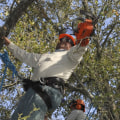There is never a bad time to remove dead, damaged or diseased branches. But most trees benefit from pruning in the middle or late winter. Pruning during dormancy encourages new growth as soon as the weather starts to warm. The lack of leaves after autumn allows you to easily identify branches and branches that require removal.
The exception is severely damaged, diseased or dead wood. Those dilapidated branches can and should be removed at any time. But the removal of healthy branches should only be carried out in the middle of winter, the dormant period, when the tree is essentially asleep, or in the spring, when the tree has just started to actively grow again and a new growth is being formed naturally. Usually, tree pruning or tree pruning in Texas is best when temperatures cool in the fall and before shoots begin to grow in the spring.
Removal of dead, broken or damaged limbs can be done at any time. The worst time to prune a tree is in spring, right after it has sprouted. The tree will have already used its energy to start new growth and will not be able to recover from pruning as well or as quickly. At Texas Tree Surgeons, tree pruning is the most common service we offer and is essential to maintaining health and safety in our urban forest.
The requirements for pruning trees and shrubs will not only vary by species, but will also depend on the purpose of pruning. If pruning is necessary because the branches are dead and the tree or shrub represents a safety hazard, pruning can be done at any time. However, the overall health of the plant should always be taken into account before addressing pruning problems. It is important to know that harmful diseases can be easily spread if trees and shrubs are pruned at the wrong time of the year. For example, oaks (Quercus spp.) should not be pruned in late summer or early fall because this is when oak wilt disease is most active.
Pruning at the wrong time can also cause damage to trees and shrubs by removing buds, flowers or fruits that would have otherwise been produced. Trees that get the right amount of pruning when young will need less excessive pruning as they grow. Pruning trees at the right time in the fall or winter cannot compensate for the damage caused by excessive pruning, lion's tailing or hedging. It is important to note that qualified tree care specialists are pruning trees every day throughout the year without many detrimental effects. With deciduous trees, such as fruit trees, you can see when the pruning season has passed when the branches start to come out leaves again. Hello, I have a friend who wants me to cut the lower dead and some live gaps from BIRTCH AND ASH TREES. Despite the fact that a sleeping tree can better withstand these harmful types of pruning, the overall health of the tree can be irreparably harmed.
While it is generally best to prune all trees in autumn and winter, it is important to consider the particular problems of a given species. However, when there is a risk of certain diseases, such as oak wilting, painting wounds from tree pruning is an important protective measure. For most trees, both deciduous and evergreen, winter cuttings between December and February are safest. I have thought about trimming it a little to remove some of the weight of the branches and where would it be time for the beginning of February, but I have read so as not to hurt a tree with thin flow. Late winter and early spring pruning helps trees sink all of their precious energy into producing healthy new growth once temperatures start to rise again.
However, if moving isn't included in your cost or if you are trimming your own trees, look for moving services offered by your city. Having an ISA-certified arborist examine your trees before pruning them is crucial for ensuring proper care.


